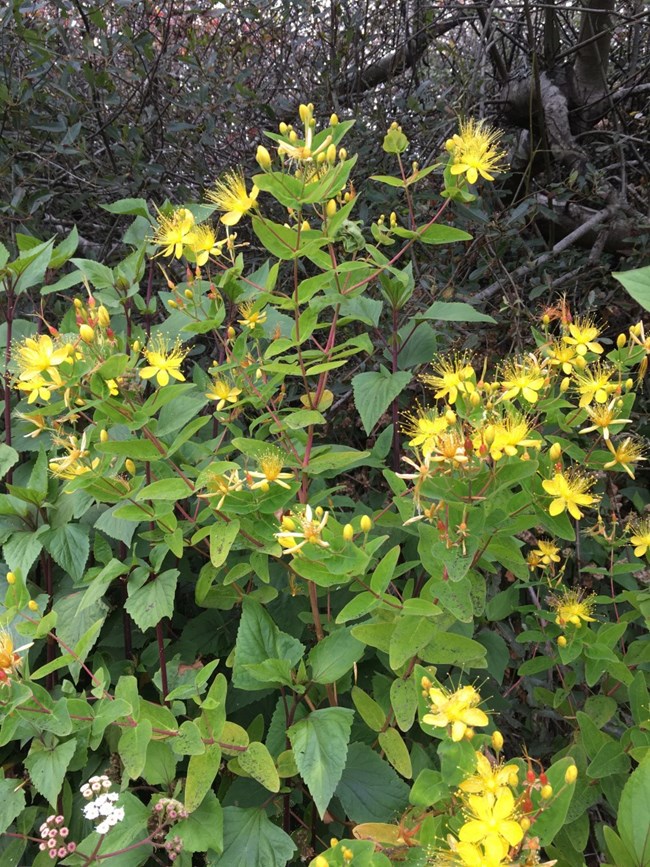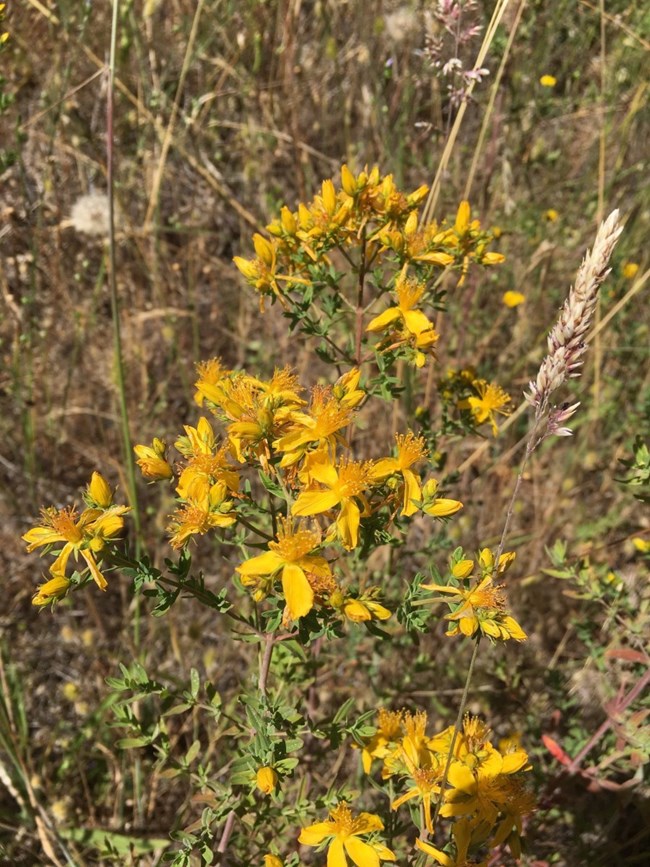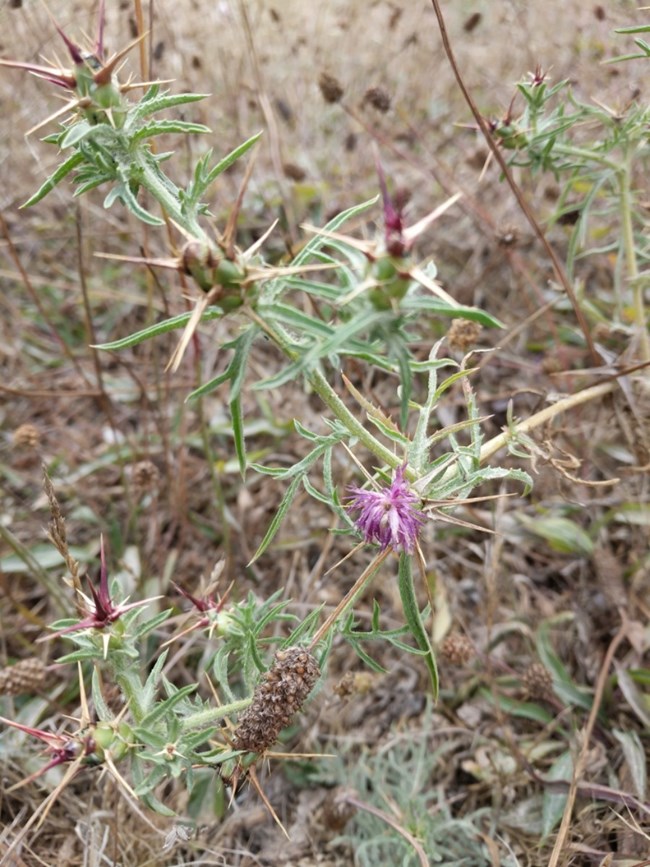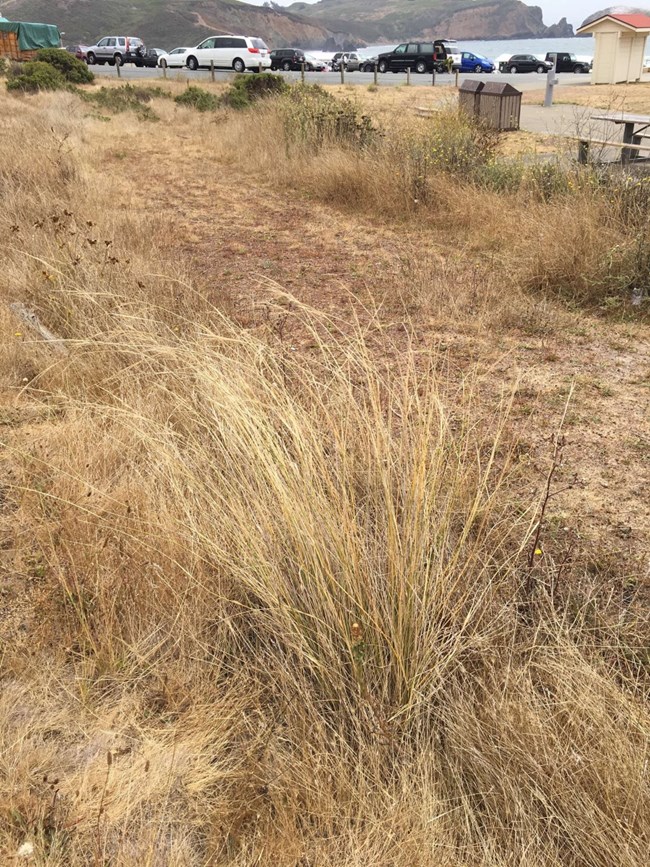Last updated: July 8, 2025
Article
Early Detection News - August 2018
August Surveys
The Invasive Species Early Detection Team (ISED) conducted August surveys at Point Reyes National Seashore and Golden Gate National Recreation Area North District. Noteworthy detections this month included malfurada, Klamathweed, purple starthistle, and Andean tussockgrass.
Noteworthy Early Detections

NPS / Eric Wrubel
Malfurada
(Hypericum grandifolium)
In August, ISED discovered a new patch of about 20 malfurada plants growing in a disturbed, mesic ditch along Panoramic Highway near the Dipsea trailhead at Stinson Beach. It was intermixed with thoroughwort (Ageratina adenophora), another invasive shrub species. This new patch is about 200 meters north of a previously known patch. ISED observed another very large population along Highway 1 at Audubon Canyon Ranch, scattered throughout the riparian scrub in the Volunteer Canyon wetlands. Six new patches of malfurada were also discovered by the One Tam early detection Team Clarkia in July along Lagunitas Creek in Samuel P. Taylor State Park.
Malfurada is a native to the Canary Islands and Maidera. The plants are evergreen shrubs with glandular ovate sessile leaves. The inflorescences are cymes of large, bright yellow, five-petaled flowers. It was first recorded in California in 2010, on Pine Gulch Creek in Bolinas. Malfurada is only known to be naturalized in California within Marin County, where new populations continue to be discovered each year, primarily in riparian habitats. Upon its discovery in California, it was Q-listed by CDFA (inadequate information but suspected to be economically or environmentally detrimental), and it is on the Cal-IPC watch list of potentially invasive species. Malfurada is listed as an environmental weed in South Australia and Victoria, and has been recorded as naturalized in Chile.
The closely related Canary Island St. John’s wort (Hypericum canariense) is distinguishable by its lanceolate leaves and ovoid fruits. This plant is more widely distributed in California, occurring along the coastline from Tijuana to Oregon. It is invasive in coastal sage scrub and grasslands where it can form dense stands that crowd out native species. A single plant can produce several thousand seeds from June to September, and plants can spread or re-sprout by rhizomes. Canary Island St. John’s wort was introduced as an ornamental plant and is also invasive in Hawaii and Australia. Cal-IPC classifies the potential impact of H. canariense on California’s native ecosystems as MODERATE-Alert and CDFA ranks it as a List B noxious weed.

NPS / Eric Wrubel
Klamathweed
(Hypericum perforatum)
A small patch of Klamathweed was discovered opportunistically in July by the SFAN Plant Community Monitoring crew at Point Reyes on the edge of the Coast Trail near the youth hostel. This is only the third record of this species from the Point Reyes peninsula, and the ISED crew plans to remove it in the coming month.
Klamathweed is a deep-rooted, rhizomatous herb with showy, bright yellow flowers and opposite, oblong leaves with black and clear glands dotting its surface. These glands produce an unusual poison, hypericin, which cause extreme photosensitivity to livestock if ingested. It is a serious threat to rangeland and pastures areas, as it can rapidly displace native vegetation. Mature plants can produce 15,000-33,000 seeds/year with seeds that can remain viable for 10+ years.
First discovered in California in the early 1900s near the Klamath River, Klamathweed spread rapidly across dry, west coast rangelands. By the 1940s it had become the most serious rangeland pest in California, de-valuing hundreds of thousands of acres. In 1944 a beetle (Chrysolina quadrigemina) was introduced to control Klamathweed, the first North American attempt at biological control using an insect to control a plant. Control was a huge success and by 1957 Klamathweed had been reduced by 99% in California. However, the beetles are not as effective in parts of California with colder winters or summer moisture.
Klamathweed is a native to parts of Europe and Asia. It was introduced to North America for medicinal purposes and has since become a cosmopolitan invasive weed. It reproduces vegetatively from rhizomes and is able to self-pollinate to reproduce by seed. Cal-IPC classifies the potential impact of H. perforatum on California’s native ecosystems as MODERATE-Alert and CDFA ranks in as a List C.
Resources:
Cornell University Biological Control Guide: Klamathweed Beetle

NPS / Sarah Inman
Purple Starthistle
(Centaurea calcitrapa)
In August, ISED detected and removed two small patches of purple starthistle, one at the former site of the Drake’s Bay Oyster Company, and one at the Bayview trailhead parking lot. These were follow up treatments at both sites, of previously mapped and treated occurrences. Purple starthistle is a biennial herb, bearing deeply lobed leaves with grayish hairs and long, sharp spines around the flower heads. It forms a mounding basal rosette in its first year, then bolts, flowers and sets seed during the following growing season.
Purple starthistle, a Mediterranean native, was first recorded in California near Vacaville in 1886 and has since spread across much of the state. It has been found in scattered locations in Golden Gate National Recreation Area and Point Reyes National Seashore. It is most commonly invasive in disturbed areas, especially rangelands. Grazing is not an effective suppression method as cattle avoid thistles, preferentially grazing on any other plants that would potentially compete. Cal-IPC classifies its potential impact on native ecosystems as Moderate, and it is listed as a B-rated noxious weed by the California Department of food and Agriculture.

NPS / Eric Wrubel
Andean Tussockgrass
(Stipa manicata)
A new patch of Andean tussockgrass was discovered opportunistically in August by the SFAN botanist near the “Surfer Lot” at Fort Cronkhite, Golden Gate NRA, in the Marin Headlands, this species is abundant in the lawns and landscaping at Fort Baker, the Capeheart housing area, and the Marine Mammal Center. It is sporadic elsewhere in the Headlands.
Andean tussockgrass is a 1-1.5 meter tall perennial bunchgrass. It is native to South America and likely introduced to California via sheep. It was first recorded in California on Angel Island in 1946. However, little to no documentation exists on the plant between this original sighting and 1989 when it was identified on the Sonoma county coastline.
Andean tussockgrass shares many morphological characteristics with the California’s state grass and native purple needlegrass (Stipa pulchra). S. manicata can be distinguished by its shorter florets, more developed crowns, and a smooth constructed neck situated at the top of the seed. Click here for a comparison of the seed heads. Click here for an article describing the diagnostic differences between these two grasses. Andean tussockgrass also prefers more moist, disturbed environments like ditches, depressions, and mesic grasslands. Cal-IPC classifies the statewide impact of Stipa manicata as limited.
August 2018 Survey Results
Click on a point in the map below to view additional details about a specific record. This month's ISED records may also be viewed in an interactive map at the Calflora Observation Hotline. Navigate to the Help Site for assistance using the Observation Hotline.
